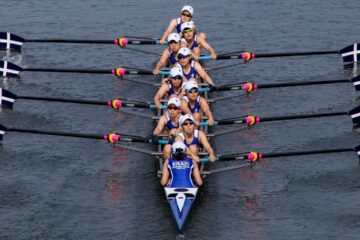As we count down to the 2024 race on the 30th of March I thought I would give a small history of the iconic event that is nearly 200 years old.
The Oxford and Cambridge Boat Race, often referred to simply as “The Boat Race,” is one of the oldest and most prestigious rowing events in the world. It is an annual contest between the men’s rowing crews from the University of Oxford and the University of Cambridge, held on the River Thames in London, England. Here is a brief history of this iconic sporting event:
Early Years (1829-1856): The Boat Race has its origins in a challenge issued in 1829 by Charles Merivale, a student at Cambridge, to Charles Wordsworth, a student at Oxford. The first race took place on February 10, 1829, and was rowed in coxed fours over a 4.2-mile course on the Thames from Hambleden Lock to Henley Bridge. Oxford won the race.
Establishment of Tradition (1856-1877): The race became an annual event in 1856, with few interruptions. The course was changed several times during these years, settling eventually on the current 4.2-mile (6.8 km) stretch from Putney to Mortlake in 1845. The event grew in popularity, drawing large crowds along the riverbanks.
Expansion and Modernization (1877-1900): During this period, the race saw increased media coverage and became a significant event in the British sporting calendar. The rivalry between the two universities intensified, with each seeking to dominate the competition. The crews began to train more scientifically, and technological advancements in boat design also influenced the race’s outcome.
Post-War Era and Global Recognition (1946-2000): Following World War II, the Boat Race resumed its annual schedule, continuing to attract widespread attention. Television coverage expanded its audience globally, making it one of the most-watched rowing events worldwide. The competitiveness of the race remained fierce, with both universities investing heavily in training and equipment.
Modern Era (2000-Present): In recent years, the Boat Race has continued to evolve, embracing technological advancements in training, equipment, and media coverage. Women’s crews from Oxford and Cambridge began competing in their separate race on the same day and course as the men’s race in 1927, gaining equal recognition and popularity over time.
Notable Moments and Records: Over the years, the Boat Race has seen many memorable moments, including close finishes, course records, and outstanding individual performances, and one dead heat in 1870. Both universities have had periods of dominance, leading to intense rivalries and thrilling competitions on the water.
Today, the Boat Race remains a symbol of tradition, sportsmanship, and academic rivalry. It attracts thousands of spectators lining the Thames banks and millions more watching on television or online, reaffirming its status as one of the most iconic and historic events in rowing and British sports history.
So why is it called the “Gemini Boat Race”? Simple, sponsorship, since 2021 Gemini, a Cryptocurrency exchange founded by “Oxford Blues” Tyler and Cameron Winklevoss (you may have heard that name as co-founders of Facebook) has been the main sponsor. Previous sponsors have been Ladbrokes, Beefeater Gin, Aberdeen Asset Management, Xchanging, and BNY Mellon.



0 Comments